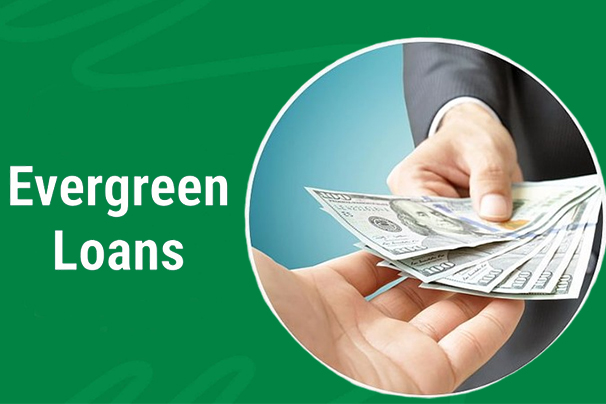An evergreen loan is generally seen as a safety net for individuals and businesses looking for financial flexibility. Furthermore, it stands out as a special financial product with a mix of accessibility and continuous utility. Unlike traditional loans that offer a set repayment schedule concluded in a final payoff, an evergreen loan operates on a revolving basis. In other words, allowing borrowers to collect funds up to a fixed limit, repay the amount used, and then have access to the funds again.

This cycle of borrowing and repayment can proceed indefinitely, provided the borrower adheres to the terms and conditions set forth by the lender. Characterized by its renewability and flexibility, the evergreen loan serves as an essential tool for managing cash flow, financing ongoing projects, or covering unexpected expenses, making it a popular choice for those who value financial agility.
What is an Evergreen Loan?
An evergreen loan is recognized as a revolving loan or a revolving line of credit and is a financial arrangement that provides a borrower with a maximum loan balance that can be borrowed, repaid, and borrowed again continuously.
Unlike installment loans, this type of loan does not have a fixed number of payments, such as a mortgage or an automobile loan. Instead, as long as the account remains in good standing and under the credit limit, the borrower can draw funds up to a certain limit, repay them, and then withdraw them again in a cycle that can continue over an extended period.
Evergreen loans are commonly used in business for operational purposes such as managing cash flow fluctuations, purchasing inventory, or covering unexpected expenses. A business credit card is a common example of an evergreen loan where the business can continuously charge and pay off amounts as needed, as long as it stays within the credit limit.
How Does it Work?
The operation of an evergreen loan revolves around a credit limit set by the lender, which is the maximum amount the borrower can access. Borrowers can draw funds as needed up to this limit. Interest is charged on the amount of money borrowed rather than the total credit limit. Regular payments are required, often monthly, which may include both interest and a portion of the principal. As funds are repaid, the available credit increases, allowing the borrower to access funds again within the limits of the credit agreement.
Types of Evergreen Loans
Without a doubt, one of the most common types of evergreen loans is credit cards. They are usually provided by banks and added to customers’ accounts. In some cases, financial companies issue credit cards as well, and you do not need to have any account relationship with them.
Other types include:
Evergreen Letter or Note
An evergreen letter of credit is typically used in international trade, providing an ongoing guarantee of payment to a seller from a buyer’s bank. It automatically renews at specified intervals unless either party decides to terminate it.
Revolving Line of Credit
This is a common form of evergreen loan, offered by banks and financial institutions. Also, it can be used for various purposes, including business operations, home improvements, or as a personal credit line.
Pros and cons
Pros
- Flexibility.
- Convenience.
- Interest Savings.
Cons
- Firstly, Potential for misuse.
- Variable interest rates.
- Lastly, Fees.
Renewal Criteria for an Evergreen Loan
Here are the renewal criteria for an Evergreen loan that every lender will consider and need:
- Collateral is Required: Many evergreen loans are secured, requiring collateral that the lender can seize if the loan is not repaid.
- Financial Statements: Lenders may require regular updates on the borrower’s financial health to assess the risk of extending credit.
- Proof of Payment Consistency: Regular, on-time payments are often a condition for the renewal of the credit limit.
Alternatives to Evergreen Loans
If you are not able to qualify for an Evergreen loan and would like to explore some alternatives, here are a few to consider:
- Home equity loans.
- Installment loans.
- Term loans.
- Credit cards.
Or, lastly, trade credit. This form of financing enables business owners to buy goods and services on account and pay the supplier later.
Frequently Asked Questions (FAQs)
How is the interest calculated on an Evergreen loan?
Interest on an Evergreen loan is typically calculated on the amount of money borrowed, not on the total available credit limit. The interest rate can be variable, changing with market conditions.
Can an Evergreen loan have a fixed end date?
No, evergreen loans are characterized by the absence of a fixed repayment date. However, lenders may periodically review the loan to decide whether to continue the arrangement.
Are there any specific requirements to qualify for an Evergreen loan?
Yes, lenders usually require a satisfactory credit score, proof of stable income, and sometimes collateral. In addition, the exact requirements can vary depending on the lender and the type of evergreen loan.
What Happens If I Can’t Make a Payment on My Evergreen Loan?
Failing to make a payment can result in penalties, increased interest rates, and negative impacts on your credit score. In cases of secured loans, the lender might also seize the collateral.
Can I Use an Evergreen Loan for Any Purpose?
Generally, yes. Borrowers can use evergreen loans for various purposes, as they are considered multi-purpose loans. Whether it is for business expenses, home renovations, or personal use, depending on the specific terms set by the lender.
